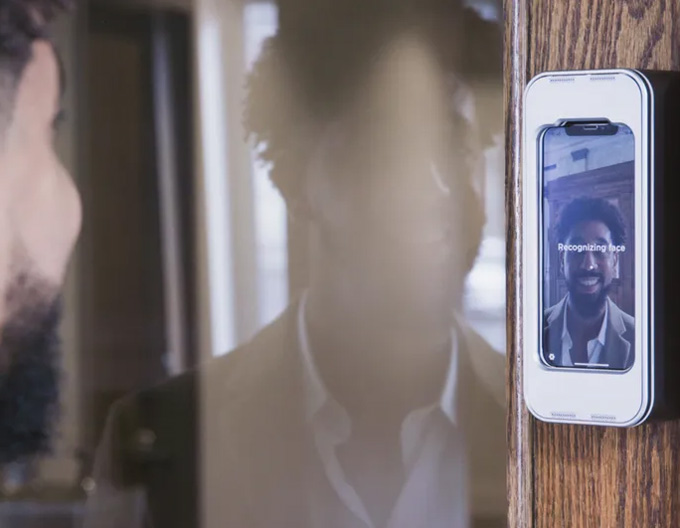
COVID-19 has complicated the management of both residential and commercial spaces.
Building managers and landlords are forced back to the drawing board to devise new plans that will ensure occupants, employees, and tenants feel safe inside buildings.
With the pandemic re-shaping the “new normal,” it’s critical to make long-term investments that will increase safety and security in an ever-changing environment.
How has COVID-19 changed building security?
COVID-19 has been the worst pandemic in the last 100 years. Governments, health agencies, property owners, and business leaders were unprepared for a disruption of this magnitude.
But lessons learned can help realize more efficient and resilient spaces. One area that has come out clearly for residential and commercial building managers is access control security.
By adopting a modern touchless access control solution, property managers are able to hit two birds with the same stone. The system provides adequate security and prevents the spread of disease-causing germs through high traffic/touch surfaces.
An excellent example of this forward-thinking approach is facial recognition access control.
How does facial recognition work?

-
Facial recognition works by using technology to identify and verify people via their unique facial features.
-
Users present themselves at a biometric scanner (usually positioned near a door).
-
The scanner will take the facial image and create a template of the user based on features such as the nose, chin, and contour of eye sockets.
-
This template will then be compared to a database of existing, pre-registered facial images to identify who the user is.
-
Once the user is identified and authenticated, they will be allowed to enter the building or facility. All this takes place within a few seconds.
-
Authorized users only need to show their faces to the scanner and the system will operate instantly.
(Touchless access control and two-way video intercom for safe, secure residential access anywhere. Courtesy of SwiftLane and YouTube.)
Based on a survey published by the National Center for Biotechnology Information (NCBI), there are certain characteristics that make a face recognition system useful:
-
Ability to work with both videos and images
-
Real-time processing
-
Robust in different lighting conditions
-
Independent of the user’s background (gender, hair, ethnicity, etc)
-
Ability to work with faces from different angles
The advanced technical nature of these features are what make facial recognition unique. More so is their capability to integrate into an access control capacity for enhanced security and safety.
How does face recognition compare with legacy systems?
Legacy access control systems typically use key cards, fobs, and other physical access tokens to identify users. These are however prone to being lost or misplaced.
If the user loses their key card, then the building manager will need to issue them with a new one. This creates inefficiencies that counter the very goal of an efficient system.
Furthermore, key cards can be hacked using relatively inexpensive equipment.
Modern facial recognition access controls utilize biometric artificial intelligence. This improves system efficiency to provide robust security at your entry points.
(Touchless access control and two-way video intercom for safe, secure office access anywhere. Courtesy of SwiftLane and YouTube.)
Facial recognition presents several unique advantages:
-
Improved security
-
Unlike key cards that can be stolen or hacked, facial recognition access control provides sound security at your entry points.
-
Compromising a face recognition system would require an immense amount of effort.
-
Furthermore, AI-based face recognition is getting better by the day.
-
-
User convenience
-
One of the best things about face recognition door access systems is user-friendliness.
-
Your tenants or employees only need to show their faces and the system will seamlessly open the door.
-
Already, hundreds of millions of people already use Face ID to quickly unlock their smartphones.
-
-
Touchless (and hygienic) access
-
Legacy access control systems require the physical exchange of cards.
-
In light of the COVID-19 pandemic and increased awareness on the spread of disease-causing germs, this may not be ideal.
-
Face recognition – on the other hand – allows users to get into your facility without touching anything.
-
This enables a hygienic security solution that can be aligned to your building hygiene and health policy.
-
(See how Swiftlane is bringing elite facial recognition and ultimate reliability to all entry systems worldwide – in real-time. Courtesy of SwiftLane and YouTube.)
How does face recognition access control support social distancing?
In light of the ongoing COVID-19 crisis, face recognition door access systems can also be used to support social distancing. Most conventional access control mechanisms require time.
For example, users will need more time to open doors in lock and key settings.
Lines are likely to form in facilities where physical screening by a security officer is the access control mechanism.
 And this is more so true during peak movement hours (mornings and evenings). Even technology-enabled access controls that use keypads can cause lines at your entry points.
And this is more so true during peak movement hours (mornings and evenings). Even technology-enabled access controls that use keypads can cause lines at your entry points.
Facial recognition provides a frictionless and seamless access solution.
Users do not have to worry about forgetting or misplacing their badges or key cards. They only need to momentarily pause at a camera, and they can get into your building within seconds.
This essentially decongests your entry points, supports social distancing, and essentially contributes to a more hygienic environment.
To Learn More about SwiftLane’s touchless access control solutions, please visit https://www.swiftlane.com/face-recognition/.
AST strives to meet a 3 STAR trustworthiness rating, based on the following criteria:
- Provides named sources
- Reported by more than one notable outlet
- Includes supporting video, direct statements, or photos
















